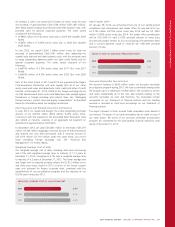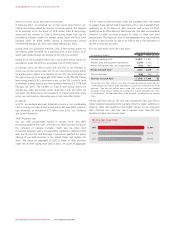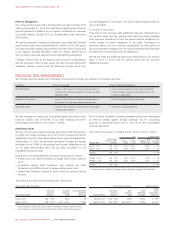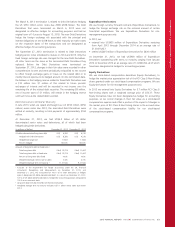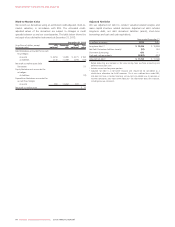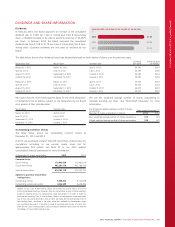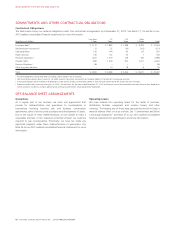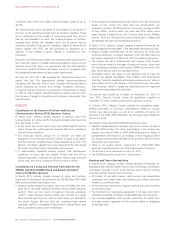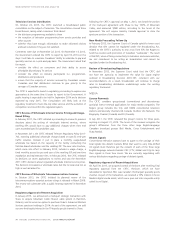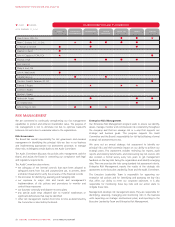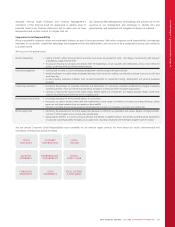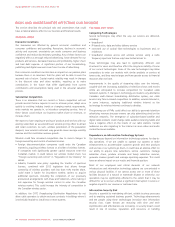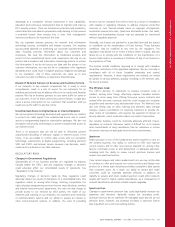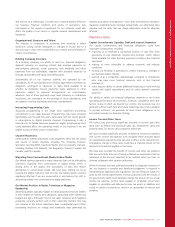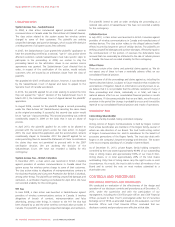Rogers 2013 Annual Report Download - page 73
Download and view the complete annual report
Please find page 73 of the 2013 Rogers annual report below. You can navigate through the pages in the report by either clicking on the pages listed below, or by using the keyword search tool below to find specific information within the annual report.
MANAGEMENT’S DISCUSSION AND ANALYSIS
• In addition, a host network carrier is neither required to provide a
roamer with a service that the carrier does not provide to its own
subscribers, or to provide a roamer with a service, or level of service,
that the roamer’s network carrier does not provide. The policy does
not require seamless communications handover.
Consultation on Transfers, Divisions and Subordinate Licensing
of Spectrum Licences
In June 2013, Industry Canada released Framework Relating to
Transfers, Divisions and Subordinate Licensing of Spectrum Licences for
Commercial Mobile Spectrum. The Framework lays out the criteria
Industry Canada will consider and the processes it will use when it
reviews spectrum licence transfers, including prospective transfers that
could arise from purchase or sale options and other agreements. Key
things to note:
• Industry Canada will review all spectrum transfer requests, and will
not allow any that result in “undue spectrum concentration” and
reduced competition. Decisions will be made on a case-by-case basis
and will be issued publicly to increase transparency.
• Licensees must ask for a review within 15 days of entering into any
agreement that could lead to a prospective transfer. Industry Canada
will review the agreement as though the licence transfer that could
arise from it has been made.
• This timing does not apply to agreements made before the
Framework was released, which means the spectrum agreements we
have with Shaw and Quebecor will not be reviewed under the
Framework until 2014.
CRTC Wireless Code
In June 2013, the CRTC issued its wireless consumer code of conduct.
Key things to note:
• The code establishes several new obligations on wireless carriers,
including contract term length, roaming caps, unlocking
requirements and contract summaries. It also lays out the rules for
device subsidies and early cancellation fees.
• Under the code, if a customer cancels a contract early, carriers can
only charge the outstanding balance of the device subsidy they
received, which goes down by an equal amount every month over no
more than 24 months. This effectively makes the maximum contract
length two years.
• The code applies to all contracts entered into or renewed after
December 2, 2013.
• As of June 3, 2015, the code will apply to all contracts, no matter
when they were entered into, which means it will retroactively
capture three-year contracts entered into between June 3, 2012 and
December 2, 2013. Anyone entering into a three-year contract
between June 3, 2012 and December 2, 2013 may therefore be
entitled to cancel their agreement without paying back the full
subsidy they received. We do not believe that the CRTC has the
authority to do this, and on July 2, 2013, Rogers, Bell, Telus, MTS
and Sasktel filed an appeal of this retroactivity provision of the code.
The Court has granted leave to appeal and will hear the case in
2014.
CRTC Request for Information Regarding Domestic and US
Wireless Roaming
In August 2013, all Canadian wireless carriers received a letter from the
CRTC asking that information about their retail and wholesale domestic
and US roaming rates, revenues and agreements be filed by
September 27, 2013. The Commission stated “The data requested will
provide the Commission with information on wireless roaming in order
to assess its impact on the competitiveness of the Canadian wireless
industry and the choices available to Canadians”.
Following the fact-finding exercise, on December 12, 2013, the CRTC
issued a call for comments entitled Wholesale mobile wireless roaming
in Canada – Unjust discrimination/undue preference (Telecom Notice of
Consultation CRTC 2013-685). Following its earlier fact-finding exercise
to assess the impact of wholesale mobile wireless roaming
arrangements on the competitiveness of the Canadian wireless industry,
the Commission initiated this proceeding to consider whether or not, as
a question of fact, there is a situation of unjust discrimination or undue
preference with respect to wholesale roaming arrangements in Canada.
The Commission noted in particular that the wholesale roaming rates
paid by Canadian carriers were higher than the rates paid by American
carriers. In addition, the Commission intends to initiate a separate
proceeding in early 2014 to further examine matters related to the
wholesale mobile wireless roaming market in Canada and the impact
on the competitiveness of the industry.
Government Announcement Regarding Roaming Rates and
Enforcement
In December, the federal government announced that it would
introduce legislation in 2014. Firstly, it would enact a legislation that
would cap wholesale domestic roaming rates at a rate no higher than
the rates the carrier charges its own retail customers. Secondly, the
government would amend the Radio-communications Act and the
Telecommunications Act to permit Industry Canada and the CRTC to
impose monetary penalties in order to enforce telecommunications
regulations. Details of the announced legislation have not yet been
released.
CABLE
Vertical Integration
The CRTC considers our Cable business to be vertically integrated
because we own or control both programming and distribution services.
It sets out the rules for vertically integrated companies in the broadcast
sector in its Broadcasting Regulatory Policy CRTC 2011-601. The policy:
• Does not allow companies to make their television programs
exclusive to their mobile or Internet subscribers. Any program
broadcast on television, including hockey games and other live
events, must be made available to competitors under fair and
reasonable terms.
• Allows companies to offer exclusive programming to their Internet or
mobile customers provided it is produced specifically for an Internet
portal or a mobile device.
• Adopts a code of conduct to prevent anti-competitive behaviour and
ensure all distributors, broadcasters and online programming services
negotiate in good faith. To protect Canadians from losing availability
of a television service during negotiations, broadcasters must
continue to provide the service in question and distributors must
continue to offer it to their subscribers.
• Required vertically integrated entities to report by April 2012 on how
they have provided consumers with more flexibility in the services
that they can subscribe to through, for example, pick-and-pay
models. In our April 2012 report, we presented the results of a
market trial we conducted in London, Ontario that provides
additional programming flexibility to consumers.
2013 ANNUAL REPORT ROGERS COMMUNICATIONS INC. 69


